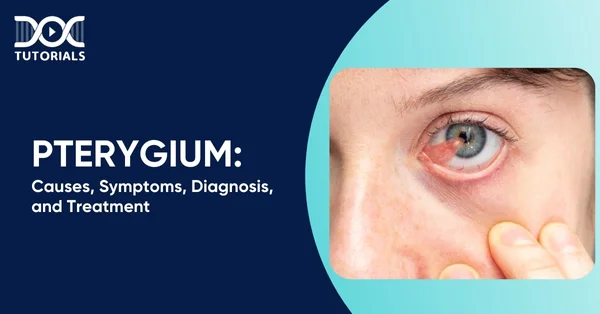Pterygium: Causes, Symptoms, Diagnosis, and Treatment

Pterygium is a benign, wedge-shaped conjunctival growth that tends to extend onto the cornea. It is most commonly associated with prolonged exposure to ultraviolet (UV) light, dusty environments, and wind.
Although pterygium is harmless, it can cause eye discomfort and may impair vision if it worsens. If you’re a NEET PG aspirant, understanding conditions such as pterygium is crucial for the exam.
DocTutorials offers detailed, exam-focused study materials that simplify complex ophthalmological topics, ensuring students grasp the essentials and ace their exams confidently. Keep reading for a thorough insight into pterygium.
What is Pterygium?
Pterygium, which is often called “surfer’s eye,” is a harmless, raised, fleshy growth that forms on the conjunctiva, the clear tissue that covers the white of the eye. It can also grow on the cornea. It usually looks like a triangle or wing-like spot that starts at the inside corner (near the nose) and moves towards the iris.
This growth is linked to prolonged exposure to the sun, wind, dust, and dry air. When it first appears, it may not cause any symptoms; however, as it grows, it may cause redness, discomfort, or blurred vision. Individuals who spend a significant amount of time outdoors, particularly in tropical regions, are more likely to develop pterygium.
What are the Causes of Pterygium?
Long-term exposure to ultraviolet (UV) radiation, especially in sunny, equatorial settings, is what commonly causes pterygium. Wind, dust, pollen, and dry air are all environmental irritants that can also cause persistent eye irritation.
People who labour outside without UV protection are more likely to have pterygium. UV damage, oxidative stress, and inflammation on the surface of the eye can cause pterygium. These things can cause aberrant tissue growth and the formation of this wing-shaped conjunctival lesion.
What are the Risk Factors of Pterygium?
Here are some important things that can make you more likely to have pterygium:
- Age 60 years or older
- Living in bright, equatorial areas (the pterygium belt)
- Outdoor activities that last a long time without sun protection
- Being around wind, sand, smoke, and dust for a long time
- Genetic susceptibility (a family history of pterygium)
- Not getting enough vitamin A
- Not using sunglasses or other protective equipment often enough
- Infection with human papillomavirus (HPV)
To prevent pterygium from occurring, it is essential to identify and address these risk factors, particularly in individuals who are at a higher risk.
What are the Symptoms of Pterygium?
When symptoms start to appear, they can be mild or quite severe. Below are some frequent signs of pterygium:
- Conjunctivitis causes swelling and inflammation.
- The eye may look red or have bloodshot spots.
- Eyes that are dry
- Eye pain
- Too much tearing
- The lesion grows larger and spreads more extensively.
- Changes in eyesight, like blurry or double vision
- A pink bump on the eye that may keep getting bigger
- A feeling like something is in your eye
- Itching in the eye
- A burning feeling in the eye
- Problems or pain when wearing contact lenses
- A feeling of sand or dirt in the eye
What is the Diagnosis for Pterygium?
It is normally easy to determine if you have pterygium, and a regular eye checkup can help with this. Eye care professionals utilise a variety of tools to diagnose and monitor conditions. These are the most prevalent ways to diagnose:
- Slit-Lamp Exam: This test uses intense light to examine the eye in detail, helping to determine the size, location, and spread of the tumour.
- Vision Acuity Test: These tests assess your visual acuity, particularly if the pterygium is impairing your ability to see.
- Corneal Topography: This computerised approach of tracing the corneal curve can find problems like astigmatism caused by pterygium.
- Photo Documentation: This involves taking close-up pictures of the eye over time to observe how the lesion progresses.
- Tear Function Tests: If you have dry eyes, these tests can be performed to assess the severity of your dry eye condition and evaluate the quality of your tear production.
What is the Treatment for Pterygium?
- Monitoring: If the pterygium is small and asymptomatic, no treatment is necessary; follow-up visits are used to monitor its growth.
- Medications: To relieve redness or irritation, physicians may prescribe lubricating eye drops, artificial tears, or corticosteroid eye drops to decrease inflammation.
- Surgical Excision: When pterygium causes discomfort, vision problems, or cosmetic issues, surgical excision is indicated. The most effective is excision with conjunctival autograft, which has the lowest recurrence.
- Amniotic membrane grafts are performed when future eye surgeries are probable. Bare sclera excision is performed less often as it has a high recurrence rate.
FAQs about Pterygium
- What are the different phases of pterygium?
There are four phases of pterygium:
Stage 1 (just in the limbus)
Stage 2 (little damage to the cornea)
Stage 3: The pupillary margin is reached.
Stage 4: Central vision is blocked.
- How quickly does a pterygium grow?
A pterygium is a type of scar tissue that grows on the conjunctiva, which is the membrane that covers the eyeball, and on the cornea, which is the clear surface at the front of the eye. A pterygium usually grows very slowly, over the course of many years.
- What will happen if you don’t cure a pterygium?
If you don’t take care of a pterygium, it might grow across the cornea, which is the clear “window” that covers the pupil and iris. This could worsen your eyesight and make the pterygium more noticeable. In certain cases, surgery may be necessary. Even if surgery works, it can’t stop pterygia from coming again.
- Which vitamin is excellent for pterygium?
Vitamins A, C, and E, as well as minerals such as zinc and selenium, can help protect the eyes and may even aid in the treatment of pterygium. Bilberry, zeaxanthin, lutein, and astaxanthin are antioxidants that help stop inflammation and protect the tissues in the eyes.
- What can I do to lower my risk of getting pterygium?
Wear sunglasses that protect your eyes from UV rays when you’re outside, and use artificial tears to keep your eyes safe from dry, windy, and dusty places.
Conclusion
Pterygium may seem like a mild eye condition, but its impact on vision and appearance can be significant. Understanding its causes, symptoms, and treatments is crucial, especially for medical students and NEET PG candidates.
With systematic, high-quality study resources from DocTutorials, you can confidently approach topics such as pterygium and remain ahead in your medical career. Join DocTutorials’ NEET PG course for an in-depth study guide to achieve success in the NEET PG exam and your medical career.
Latest Blogs
-

NEET SS Exam 2024: Analysis, Key Dates, Counselling
The NEET SS 2024 exam kicked off on March 29, 2025. Over two days and two slots, candidates across 13…
-

NEET PG Registration 2025: An Essential Guide For Exam Prep
The NEET PG registration, which is conducted online, is a crucial step in the exam process. Filling out the NEET…
-

NEET PG Syllabus 2025: A Must-Have Complete Guide for Exam Success
The NEET PG Syllabus acts as one of the foundation stones for aspiring postgraduate medical students like you who are…




